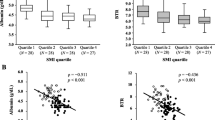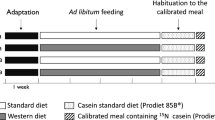Abstract
The aim of the study was to explore if changes in muscle and plasma amino acid concentrations developed during growth and differed from levels seen in adults. The gradient and concentrations of free amino acids in muscle and plasma were investigated in relation to age in metabolic healthy children. Plasma and specimens from the abdominal muscle were obtained during elective surgery. The children were grouped into three groups (group 1: < 1 year, n = 8; group 2: 1–4 years, n = 13 and group 3: 5–15 years, n = 15). A reference group of healthy adults (21–38 years, n = 22) was included in their comparisons and reflected specific differences between children and adults. In muscle the concentrations of 8 out of 19 amino acids analysed increased with age, namely taurine, aspartate, threonine, alanine, valine, isoleucine, leucine, histidine, as well as the total sums of branched chain amino acids (BCAA), basic amino acids (BAA) and total sum of amino acids (P < 0.05). In plasma the concentrations of threonine, glutamine, valine, cysteine, methionine, leucine, lysine, tryptophane, arginine, BCAA, BAA and the essential amino acids correlated with age (P < 0.05). These results indicate that there is an age dependency of the amino acid pattern in skeletal muscle and plasma during growth.



Similar content being viewed by others
References
Bergström J, Fürst P, Norée L-O et al (1974) Intracellular free amino acid concentration in human muscle tissue. J Appl Physiol 36:693–697
Brunton JA, Ball RO, Pencharz PB (2000) Current total parenteral nutrition solutions for the neonate are inadequate. Curr Opin Clin Nutr Metab Care 3:299–304
Canepa A, Filho JC, Gutierrez A et al (2002) Free amino acids in plasma, red blood cells, polymorphonuclear leukocytes, and muscle in normal and uraemic children. Nephrol Dial Transplant 17:413–421
Davis TA, Fiorotto ML (2009) Regulation of muscle growth in neonates. Curr Opin Clin Nutr Metab Care 12:78–85
Dickerson WT, Widdowson EM (1960) Chemical changes in skeletal muscle during development. Biochem J 74:247–257
Eaton S (2003) Impaired energy metabolism during neonatal sepsis: the effects of glutamine. Proc Nutr Soc 62:745–751
Elango R, Ball RO, Pencharz PB (2008) Individual amino acid requirements in humans: an update. Curr Opin Clin Nutr Metab Care 11:34–39
Friis-Hansen B (1971) Body composition during growth; in vivo measurements and biochemical data correlated to differential anatomical growth. Pediatrics 47:264–274
Fürst P (1983) Intracellular muscle free amino acids—their measurement and function. Proc Nutr Soc 42:451–462
Gore DC, Jahoor F (2000) Deficiency in peripheral glutamine production in pediatric patients with burns. J Burn Care Rehabil 21:172–177
Hammarqvist F, Jacks J, Wernerman J (1998) Effects on skeletal muscle amino acids and whole body nitrogen metabolism of total parenteral nutrition following laparoscopic cholecystectomy and given to healthy volunteers. Clin Nutr 17:205–210
Hammarqvist F, Anderson K, Luo J-L et al (2005) Free amino acid and glutathione concentrations in muscle during short-term starvation and refeeding. Clin Nutr 24:236–243
Imura K, Okada A (1998) Amino acid metabolism in pediatric patients. Nutrition 14:143–148
Kamata S, Imura K, Kawahara H et al (1995) Early postoperative change of plasma levels of amino acids in neonates with perforative peritonitis and its prognostic significance. J Pediatr Surg 30:559–562
Kien CL, Young VR, Rohrbaugh DK et al (1978) Whole-body protein synthesis and breakdown rates in children before and after reconstructive surgery of the skin. Metabolism 27:27–34
Kriketos AD, Baur LA, O’Connor J et al (1997) Muscle fibre type composition in infant and adult populations and relationships with obesity. Int J Obes Relat Metab Disord 21:796–801
Lepage N, McDonald N, Dallaire L et al (1997) Age-specific distribution of plasma amino acid concentrations in a healthy pediatric population. Clin Chem 43:2397–2402
Möller P, Bergström J, Eriksson S et al (1979) Effect of aging on free amino acids and electrolytes in leg skeletal muscle. Clin Sci 56:427–432
Neu J, Roig JC, Meetze WH et al (1997) Enteral glutamine supplementation for very low birth weight infants decreases morbidity. J Pediatr 131:691–699
Neu J, DeMarco V, Li N (2002) Glutamine: clinical applications and mechanisms of action. Curr Opin Clin Nutr Metab Care 5:69–75
Perfumo F, Canepa A, Divino Filho JC et al (1994) Muscle and plasma amino acids and nutritional status in kidney-transplanted children. Nephrol Dial Transplant 9:1778–1785
Pierro A (2002) Metabolism and nutritionalsupport in the surgical neonate. J Pediatr Surg 37:811–822
Pointdexter BB, Ehrenkranz RA, Stoll BJ et al (2004) Parenteral glutamine supplementation does not reduce the risk of mortality or late-onset sepsis in extremely low birth weight infants. Pediatrics 113:1209–1215
Powis MR, Smith K, Rennie M et al (1998) Effect of major abdominal operations on energy and protein metabolism in infants and children. J Pediatr Surg 33:49–53
Roth E, Funovics J, Mühlbacher F et al (1982) Metabolic disorders in severe abdominal sepsis: glutamine deficiency in skeletal muscle. Clin Nutr 1:25–42
Snedecor GW, Cochran WG (1980) Statistical methods, 7th edn. The Iowa State University Press, Ames, pp 141–143
Stehle P, Mertes N, Puchstein C et al (1989) Effect of parenteral glutamine peptide supplements on muscle glutamine loss and nitrogen balance after major surgery. Lancet 1:231–233
Vinnars E, Bergström J, Fürst P (1975) Influence of the postoperative state on the intracellular free amino acids in human muscle tissue. Ann Surg 182:665–671
Waterlow JC, Golden M, Picou D (1977) The measurement of rates of protein turnover, synthesis, and breakdown in man and the effects of nutritional status and surgical trauma. Am J Clin Nutr 30:1333–1339
White DR, Widdowson EM, Woodard Q et al (1991) The composition of body tissues. Br J Radiol 64:149–159
Young VR, Borgonha S (2000) Nitrogen and amino acid requirements: the Massachusetts Institute of Technology amino acid requirement pattern. J Nutr 130:1841S–1849S
Acknowledgements
The skilled technical assistance of Mrs Christina Hebert and Mrs Liselott Thunblad are gratefully acknowledged. Sources of financial support: The Swedish Medical Research Council (Project 04210), The Stockholm County Council, Public Health and Medical Science, Department of Development and Teaching, the TRYGG-HANSA Research Fund and the Åke Wiberg Research Fund, The Crown Princess Lovisa and Axel Thielman Foundation.
Author information
Authors and Affiliations
Corresponding author
Rights and permissions
About this article
Cite this article
Hammarqvist, F., Angsten, G., Meurling, S. et al. Age-related changes of muscle and plasma amino acids in healthy children. Amino Acids 39, 359–366 (2010). https://doi.org/10.1007/s00726-009-0446-1
Received:
Accepted:
Published:
Issue Date:
DOI: https://doi.org/10.1007/s00726-009-0446-1




